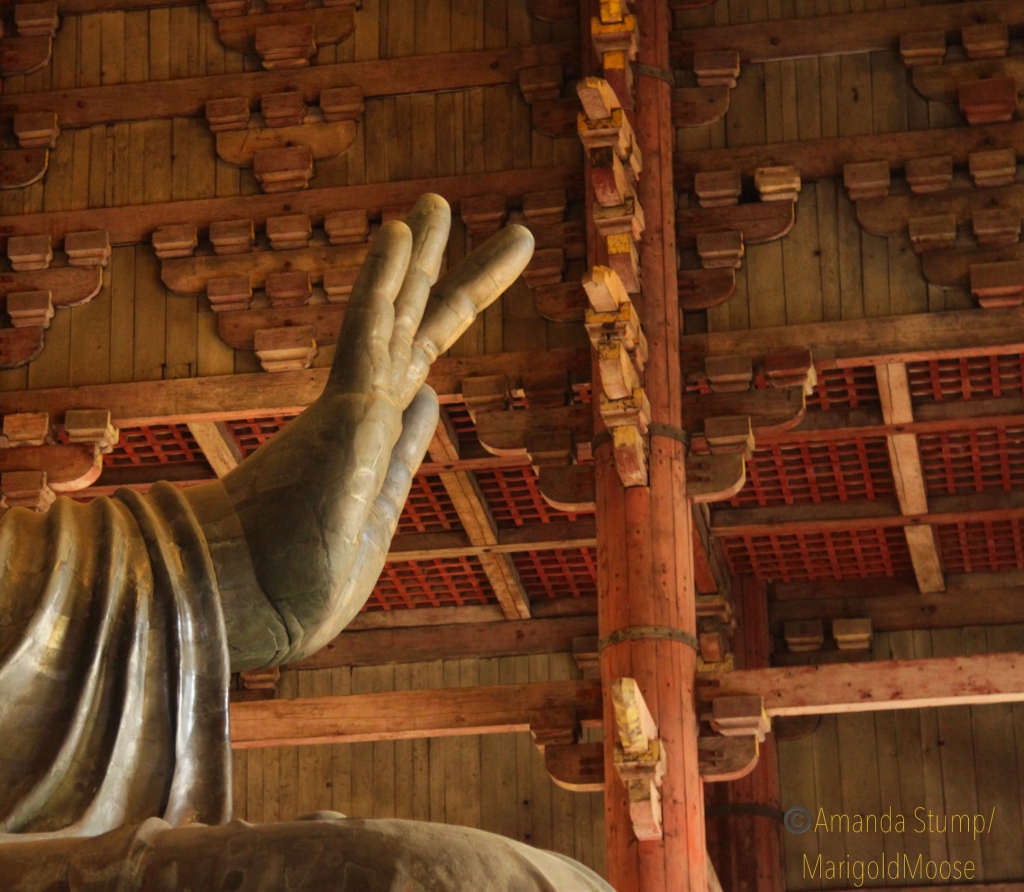This will be part of a series on a week in Japan. We stuck to Kyoto and Nara only, and while we didn’t see everything (that would take months) we hit some popular attractions and some more out-of-the-way places. We went in mid-April, which happened to be cherry blossom season (believe it or not, we did not plan that!) We had a few plans of what we wanted to see, but mostly we found things by chance while wandering.
This post will cover the Tōdai-ji complex. There are interactive itinerary maps at the end of this post that cover the entire day (there’s a lot). Day 1 included the Tōdai-ji complex, the Kofuku-ji complex (the golden Buddha and a 5-story pagoda), the Katsugataisha botanical gardens, and the Katsuga-taisha Shinto Shrine. I’ll highlight a couple places we stopped and ate too!
(Click on any picture for a larger image).

We actually stayed in Kyoto, in a traveler’s hotel right by the train station. It had breakfast included and an onsite spa bath (but not if you have tattoos). We were usually the only gaijin (foreigners in Japanese) there. Since we were still on US time and didn’t acclimate all that well, we ended up trying to visit the places we knew would be busy as soon as they opened (though some are open 24/7, even easier and fewer people). The first day (Sunday) we decided to visit Nara and the Great Buddha Hall (Daibutsu-den) at Tōdai-ji, as it is really popular and usually packed. From Kyoto to Nara takes about an hour by train.
The train ride to Nara (what I was awake for) was really pretty. Little farms all over and blooming cherry trees speckled throughout. Japan is an absolutely beautiful country.

The lovely Kintetsu-Nara train station 
Gyoki (a Buddhist priest of the Nara Period) outside the Nara trans station
From the train station, we headed directly to Tōdai-ji (the Great Buddha Hall), as we knew it gets crowded quickly. We saw some very quirky and oh-so-Japanese things on the way, like the vending machine for cat hats and how a building was built around a tree (how all buildings should be built!) I also of course had to take a picture of a truck from my favorite delivery company, Yamato Transport (or kuroneko, meaning “black cat”).
Nara deer, thought to be messengers of the gods, dot this area of Nara and are protected. They are beautiful, friendly, and will also assault you for cookies. Or knock you down?

Also, many will bow to you if you bow first (a deer biscuit helps). SO polite, and how often do you get to bow to a messenger of the gods?!
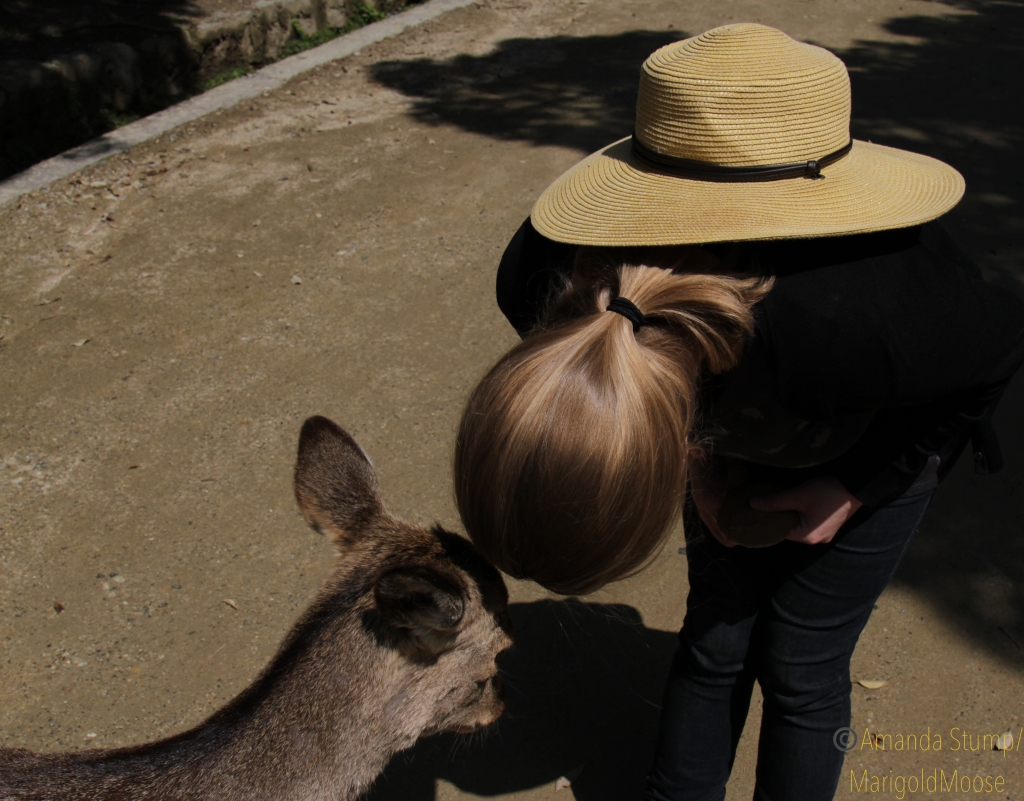
The deer are Sika deer (Cervus nippon) and are quite a bit smaller than white tails or mule deer (the US actually has Sika deer too). They are really everywhere around the deer park in Nara. You can feed them, but only deer crackers (which can be purchased from vendors inexpensively) as other foods can make them sick. They also seem to love eating cherry blossoms (sakura).

Nara in general is very clean and pretty. They really do love their deer, and you can see their images on so many things around town.
The Tōdai-ji (temple) was (originally) built in the 700s and has the largest bronze Buddha in Japan. Before you get to Tōdai-ji, you will enter the temple complex through the Great South Gate (Nandai-mon Gate) of Tōdai-ji, which is, in itself, amazing. (I will have posts in the future that go through the history of these locations, stay tuned!) The gate was built in the 1200s, and contains two Nio, or temple guardian statues, carved out of wood.
Nio are commonly found at Buddhist temples and guard the temple from evil spirits (they are guardian kings and found in pairs). It’s hard to get a scale of those at Tōdai-ji, but in the image below I am not even as tall as the white fence in front and I am 5’2″. So they are MASSIVE at about 28 feet tall (8.4 meters). And carved entirely from wood. It’s hard to get a good picture as they are behind glass for protection, but they are very impressive in person.
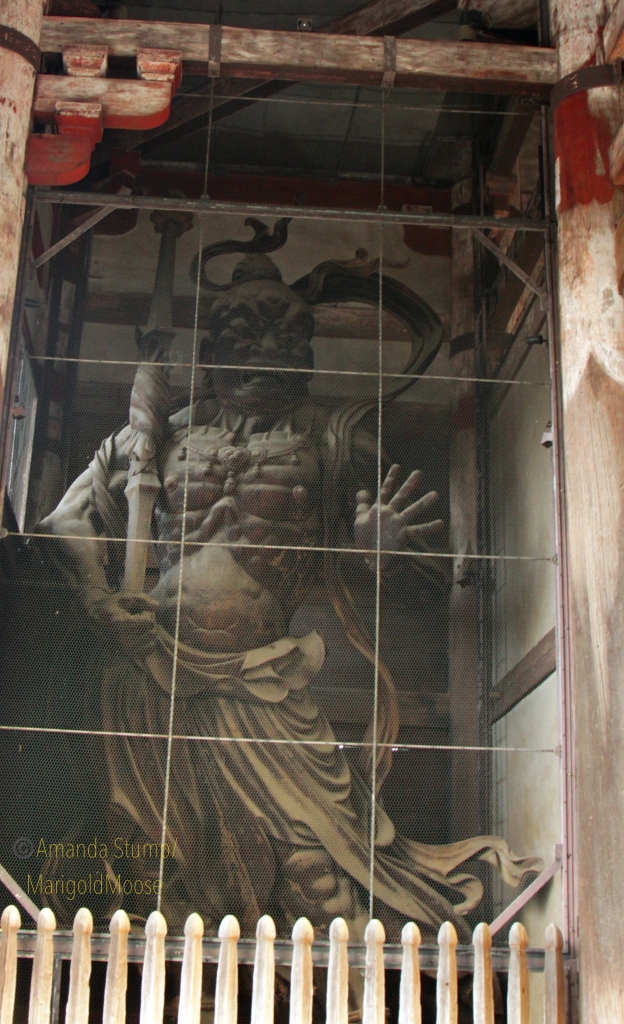
We actually go to Tōdai-ji so early that it wasn’t open yet (it opens at 8:00am), but the temple grounds are open 24 hours a day so we strolled around. There is a lot to see at Tōdai-ji– you could spend hours without ever going into the Great Buddha Hall itself. Of note is the Tōdai-ji bell, which is surrounded by sakura trees and, seemingly like everything in this complex, is huge. The complex has beautiful architectural details everywhere too. It’s very quiet and peaceful, especially in the early morning. It was also a bit uncharacteristically cold for April when we were there, so that also kept the crowds down (good for us, cold is my friend!)
After wandering the grounds, we headed toward Daibutsu-den. There is a beautiful pond in front of it known as Kagamiike. Deer wander through the entire complex. I saw a couple ducks too, and there are koi in the pond.

Before entering the Daibutsu-den itself, there is an additional gate that denotes entry to the hall complex. The orange color commonly is associated with Shintoism, but this is definitely a Buddhist shrine. There are phoenix designs on the gate decorations as well, which is usually a sign of the imperial family (especially the Empress), but it can also mean grace.
Another stop of note just outside Daibutsu-den is the octagonal lantern, which is a national treasure. It’s quite large (of course!) and really ornate and dates to the 8th century. (I have no idea why my picture is slanted, I blame the fact that it was early and Japanese coffee is much weaker than what I am used to).
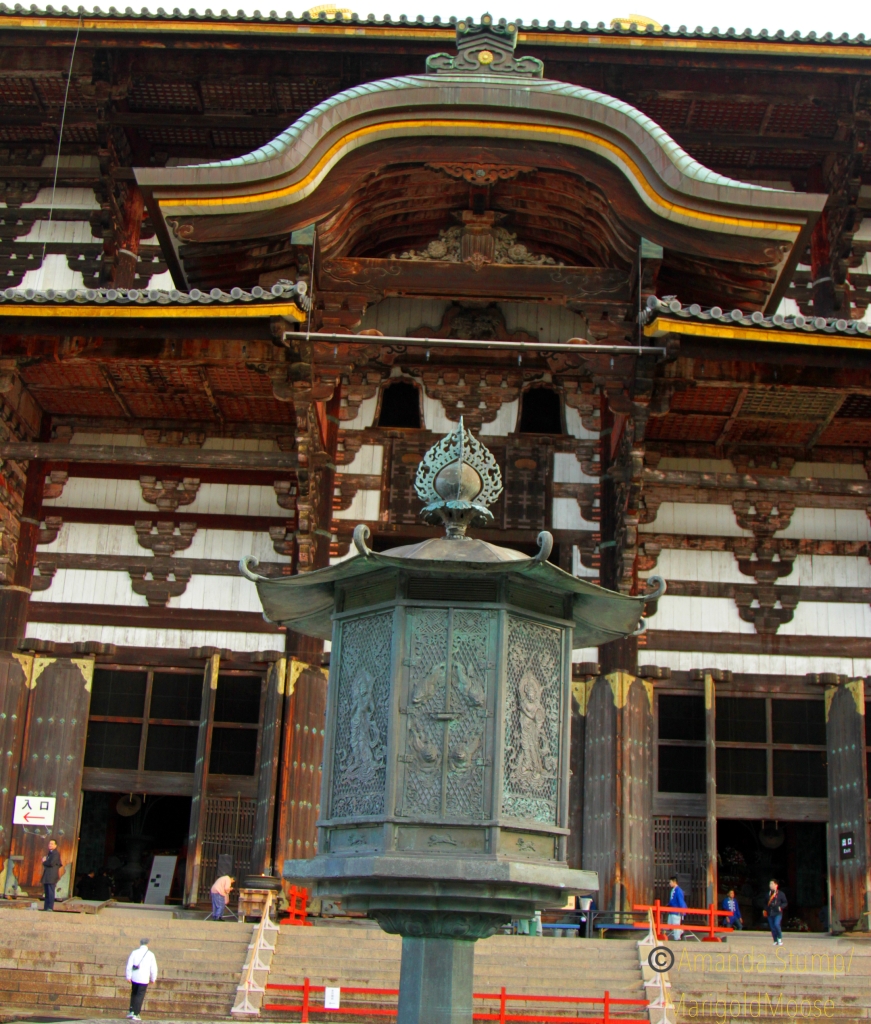
The Daibutsu-den itself is the largest wooden structure in the world (it burned on several occasions previously, and was once even larger than it is now). It’s hard to get a sense of scale, but it is immense. Everything is Japan is so precise, even the grounds were absolutely perfect.
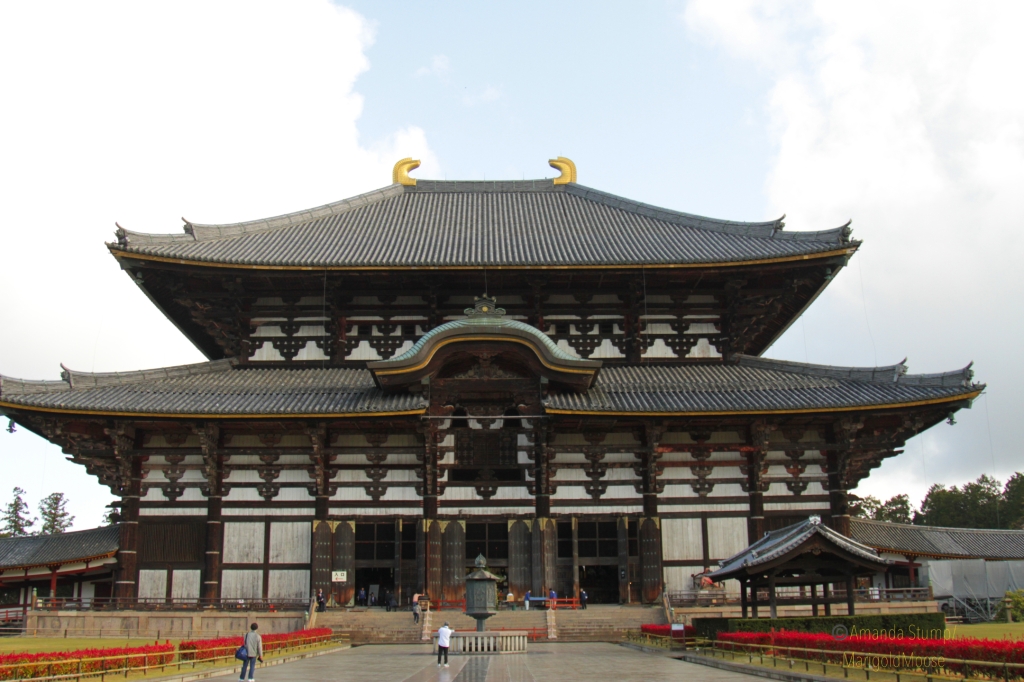

When we were at the temple, there was some sort of a meeting or event with a group visiting the shrine (from a Japanese company, I think). A beautiful and elaborate flower arch was set up as part of the celebration. This was on the main terrace, just outside one of the main doors. I think it was part of the altar decorations, but I need to look into it more.
Once inside the Daibutsu-den, the giant bronze sculpture of Daibutsu is right at the front. From the image below, you can see the sense of scale. It’s much bigger than I imaged; the seated height is just under 50 feet tall (15.24 meters). This temple allows and encourages pictures, but not all temples in Japan do (the golden Buddha hall does not allow pictures, more on that in a minute). Respect that these are religious sites and follow the rules and respect those paying their respects. If someone was praying, I would wait for them to finish, bow to them (it always surprises Japanese when Americans bow politely!), and then snap my pictures after saying “sumimasen” (“pronounced soo-me-ma-sen,” excuse me in Japanese). Being kind goes a long way!

The hall actually goes quite a ways back from the giant Buddha statue, and there is a scale model of the original (much bigger!) structure. The original hall was absolutely massive on a scale that is hard to comprehend. There are also two additional statues at each corner of the building, these aren’t exactly Nio but similar. They are temple guardians called Komokuten. Each is made fully of wood. I love their expressions (I think I have the same one…most days) and the carving is so intricate.
Another interesting item in the temple is a tall wooden pillar with a hole in it. This is known as “Buddha’s nostril” and is (supposedly) the same size as the nostril of the Bronze Buddha. Legend has it that if you crawl through the hole you will have good luck. I *might* have fit through, but I had visions of temple security guards having to extract me with grease or the jaws of life (honestly I wonder how many people get stuck) so I didn’t try it.

To the right of the Bronze Buddha is a bodhisattva called Kokuzo Bosatsu, which is the bodhisattva of memory and wisdom. I study neurotrauma and memory issues, so I spent a little more time with this bodhisattva. This statue is (relatively) more recent and was built in the 1700s and has been (like the bronze Buddha) restored many times over the years. The candle soot tends to leave a coating on everything over the years that needs to be removed and the building and statues preserved.
Speaking of replacement and refurbishment, at the front of the temple there is one of the finials from the roof that was removed. To give you more of a sense of scale, it’s probably over 20 feet tall and yes, that is gold leaf covering it. I am by no means tall, but I felt so tiny at this entire complex.
After leaving the Daibutsu-den, we headed nearby to the Kōfuku-ji, which is another Buddhist temple complex. Here is the Central Golden Hall, which contains a large golden Buddha (known as Chū-kondō) and a 5 story pagoda. Photographs are not allowed inside the Chū-kondō, and (as you can see below) I didn’t get great pictures of the pagoda (let’s blame the sun for this one, and not me being lazy and not adjusting mu camera settings). I did get an image of the outside of Chū-kondō though, and you can see it has the same style finials as the Daibutsu-den. The golden Buddha is also quite impressive, though not quite as large as the bronze Buddha.
After Kōfuku-ji, we headed back toward the train station for some lunch. We stopped at a cute and tiny cafe by chance, called the Cafe Plum. The owner is so incredibly sweet, and the food was simple but amazing. There is an English language menu as well. I had coffee and green tea (not mixed, I’m not that weird) and we shared a sandwich and all was quite good. It is open for breakfast and lunch, and the location is on the map below. I’ll also link the TripAdvisor review here, as it’s not actually on Google maps.
Heading out of the cafe I saw this beautiful manhole cover with the Nara deer and sakura (check out my favorite travel/hiking boots, too!). I guess there is a checklist you can use to find a bunch of these decorative covers throughout Japan, which I didn’t know until recently. I was just amazed so much care and thought was put into something like a manhole cover. Japan is truly beautiful. The second half of our Day 1 in Nara will follow soon!

The (interactive) maps for our itinerary are below. This was all done in one day with plenty of stops. Japan is very walking-intensive, but there are also plenty of places to rest and enjoy beautiful scenery.

























